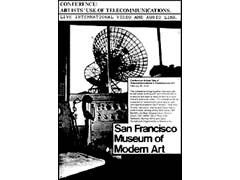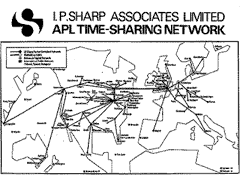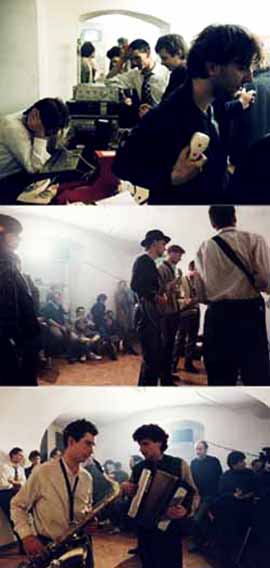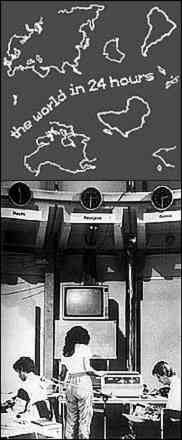Art and Telecommunication, 1979-1986: The Pioneer Years
Autore: Adrian Robert
Art and Telecommunication, 1979-1986: The Pioneer Years http://telematic.walkerart.org/overview/overview_adrian.html
Artists' Use of Telecommunications Conference, 1980
Artex and I.P. Sharp Assoc. network map
Art and Telecommunication,
1979-1986: The Pioneer Years
Robert Adrian
I progetti descritti qui sotto sono selezionati per mostrare lo sviluppo dell’ uso degli artisti delle telecomunicazioni e per indicare i vari mezzi usati e la sofisticatezza della loro esecuzione. Questo sommario si concentra sui progetti che includono una partecipazione austriaca o provengono dall’ Austria e nei quali ero personalmente implicato.
Nel 1981 Tom Klinkowstein si è associato a ARTBOX ed ha proposto un progetto telefacsimile (del FAX). Il FAX era virtualmente sconosciuto allora ma avevamo sentito parlare di esperimenti fra i gruppi degli artisti in America del Nord. Il progetto è avvenuto il 5 Agosto del 1981 fra il Mazzo Club a Amsterdam e il Blitz Barin a Vienna ed era il primo progetto con il FAX dagli artisti in Europa. Christina Schopf dall’ Ars Electronica era presente alle prestazioni nel Blitz Bar ed ha invitato me per proporre un progetto di telecomunicazioni per l’Ars Electronica del 1982. Il risultato fu "Die Welt in 24 Stunden".
Il DIE WELT IN 24 STUNDEN era il progetto più ambizioso usando apparecchiature di comunicazioni a bassa tecnologia (basata sul telefono). Ha coinvolto una rete globale di artisti e di gruppi che volevano organizzare ciascuno un contributo dalla loro posizione usando uno o tutti i mezzi tra lo SSTV, mailbox del computer, il fax o suono del telefono. Le città in questione erano: Vienna, Francoforte, Amsterdam, Bath, Wellfleet, Pittsburgh, Toronto, San Francisco, Vancouver, Honolulu, Tokyo, Sydney, Costantinopoli ed Atene. Ogni posizione è stata chiamata da Linz alle 12:00 ora locale – così il progetto è cominciato nell'Europa centrale alle 12:00 del 27 Settembre e, seguendo il sole di mezzogiorno intorno al mondo, si è concluso al mezzogiorno del 28 Settembre. A Linz sono stato aiutato da Waltraut Cooper, Norbert Hinterberger ed allievi del prof. Ortner alla Hochchule fur Gestaltung. A Vienna l'organizzazione era di Helmut Mark e di Zelko Wiener allo Österreichische Kultur Service (ÖKS) Studio.
La collaborazione con Helmut Mark e Zelko Wiener è continuata e nel 1983 abbiamo formato il verein BLIX insieme al musicista/tecnico Karl Kubaczek ed il tecnico Gerhard Taschler. Il supporto del ÖKS è continuato e quel supporto era cruciale per la maggior parte dei progetti successivi a cui gli artisti austriaci hanno partecipato. Il primo di questi progetti era "Telephone Music", un concerto al telefono organizzato da BLIX fra Vienna, Berlino e Budapest il 15 Aprile del 1983.
Il TELEPHONE MUSIC era un tentativo di utilizzare il telefono (come il mezzo di comunicazioni elettronico universalmente disponibile) per generare uno spazio comune per gli artisti attraverso le barriere ideologiche che hanno diviso allora Europa centrale - fra Vienna "occidentale", Berlino divisa e Budapest "orientale". All’ ÖKS a Vienna, ad Artpool a Budapest ed ad Aufbau/Abbau a Berlino, abbiamo collegato semplicemente i nostri telefoni agli amplificatori ed abbiamo giocato la musica in tensione l'un l'altro per un paio di ore.
WIENCOUVER IV (4 Dicembre 1983) era un progetto molto più grande che ha usato il "know-how" guadagnato da TELEPHONE MUSIC per uno scambio di 3 ore di suono ed immagine (SSTV) fra l’ ÖKS a Vienna e nella parte anteriore occidentale a Vancouver. Ero alla parte anteriore occidentale come "l’Artista-in-Residenza" e ho organizzato il WIENCOUVER IV, insieme a Hank Bull, come componente del mio programma del residency. L'organizzazione di Vienna era di Helmut Mark, di Zelko Wiener e di BLIX. Due linee telefoniche sono state usate per il suono e le bande di artisti e i SSTV, e gli esecutori sono stati invitati in entrambe le città per effettuare in linea la performance dal vivo. WIENCOUVER IV era, in effetti, un esperimento di televisione interattiva bidirezionale. A Vienna WIENCOUVER IV è stato preceduto da un concerto live al telefono con Varsavia e Berlino. A Vancouver Bill Bartlett, il pioniere del telecomm degli artisti di bassa-tecnologia, ha fatto la sua apparenza d'addio in un progetto di comunicazioni.
Come componente del mio residency anteriore occidentale inoltre ho organizzato la rete per il progetto LA PLISSURE DU TEXTE, un esperimento di ARTEX di Roy Ascott nella condizione di scrittore collettivo per la mostra ELECTRA'83 a Parigi. Ai partecipanti di 11 città del mondo sono stati assegnati i ruoli in un racconto fairy globale che è avvenuto fra l’11 Dicembre e il 23 Dicembre 1983. I ruoli erano: Alma (Quebec) - BESTIA; Amsterdam - FURFANTE; Bristol - TRICKSTER; Honolulu - UOMO ANZIANO SAGGIO; Parigi - MAGO; Pittsburg - PRINCIPE; San Francisco - SCIOCCO; Sydney - STREGA; Toronto - GODMOTHER FAIRY; Vancouver - PRINCIPESSA; Vienna - APPRENDISTA del SORCERER. ARTEX era il mezzo per LA PLISSURE ed IPSA ha fornito il tempo gratis della rete per 3 settimane per il progetto. La partecipazione a Vienna è stata organizzata da BLIX all' ÖKS Studio.
Per il Wierner Festwochen del 1984 BLIX ha organizzato KUNSTFUNK, un progetto di SSTV per la radio dilettante alla Wierner Secession. Per una settimana le stanze superiori del Secession sono state usate come studi radiofonici e spazi di prestazioni. Ogni giorno un artista o un gruppo installarono o realizzarono un lavoro per la trasmissione di SSTV. L'onda corta è stata usata per la trasmissione locale (Europa, est centrale, l'Africa) e VHF per la ritrasmissione via satellite a Pittsburgh. Il progetto è stato organizzato, installato e controllato da Zelyko Wiener, Gerhard Taschler e BLIX.
L'ultimo progetto sostenuto dall’ ÖKS era KUNST BTX, un video scomparto sperimentale del testo. Nel 1985 l'Opt introdusse BTX in Austria. Era un sistema migliore (CEPT2) che quelli in uso altrove in Europa e l'Opt ha fornito il MUPID, un computer poco costoso capace di generare delle immagini da schermo in 4096 colori. Per costituire un fondo per l’ ÖKS, Zelyko Wiener ha sviluppato la prima emissione di KUNST BTX per BLIX nell’ Agosto del 1985. Il progetto è stato continuato da Gottfried Distl, Andrea Dee e da Robert Adrian fina alla fine nel 1986 quando l’ÖKS ha terminato il sostegno ai progetti d’arte.
PLANETARY NETWORK era una parte di Laboratorio Ubiqua alla Biennale di Venezia del 1986. Curata da Roy Ascott, Tom Sherman, Don Foresta e Tomasso Trini, PLANETARY NETWORK ha riassunto tutti i progetti di telecomunicazioni di bassa-tecnologia degli artisti dal 1979. Ho organizzato la rete su ARTEX per l'ultima volta. Era inoltre l'ultimo progetto della rete completa, multimediale, globale. La rete dei personal computer in BBSs e nella presenza aumentante del FAX e di altre unità periferiche del telefono in uffici e nelle sedi ha reso ARTEX ed i progetti su grande scala del telecomm superflui. Era inoltre l'ultimo progetto per BLIX che è andato alla deriva a parte dopo che il ÖKS cambiasse la relativa politica e chiudesse l'ÖKS Studio.
I giorni dei pionieri erano finiti...
Die Pionierzeiten waren vorbei ...
http://www.t0.or.at/~radrian/KUNSTFUNK/kunstfunk.html
The World in 24 Hours RAPPORTO (Quelle: Archiv Robert Adrian X) ________________________________________
________________________________________
Vienna, December 9, 1982
It is now just over 2 months since "THE WORLD IN 24 HOURS" project took place and this report completes, finally, the documentation. The enclosed material, including copies of telefax pages, photos of SSTV images, descriptions and photos of the activities in Linz during the project, and a nearly complete copy of "ARS CONFERENCE" on the I.P.Sharp network, is a selection from all the material we received during the 24 hours. We also have over 2 hours of U-Mativ Video tape which will be edited to about 20 minutes. Dubs of this tape are available to anyone interested for the cost of tape and dubbing time.
The strain of 24 hours of non-stop activity on people and equipment is obvious in the uneven quality (and quantity) of the enclosed material ... some things didn't get recorded or photographed ... the sound recording equipment broke down ... the person with the camera went home to bed, with the camera! ... we ran out of video tape in the middle of the night when everything was locked ... one telephone died and another got very neurotic in the early morning ... we all forgot and lost things, including telephone numbers.
But on the whole it was a successfull experiment. We learned a lot ... for one thing, we learned that most things, including people are not designed for non-stop, 24 hour, activity. But we also learned that such a project is possible and that the next one will be even better given the experience we now have.
There are, of course, many things we would do differently if we had to do it all again but three things stand out: 1. More time for preparation. We had 9 months but it needed at least a year. 2. Better audio recording equipment. The ORF (Austrian Radio/TV) supplied excellent sound equipment but the wrong tape deck. We should have paid a lot more attention on this point. 3. More telephones. We had 3 lines but needed 5. For a total telecommunications experience you need all the media working at once ... plus a communication line for emergencies. Telecommunications, by artists or anybody, only gets really exciting when carried out on a global scale. But the price of global scale telecommunications projects is all the pain and problems of language and cultural differences, time zones, networking and night-working. On balance I think it is worth it ... looking through the material we received one can feel a new kind of art developing, a new medium. Its a very exciting feeling.
Lets do it again soon!
Robert Adrian X This documentation has been made possible by the cooperation of the 3M company and the Österreichische Kultur Service. ORARI DEL PROGETTO ________________________________________ LINZ
September 27 12:00 VIENNA (Helmut Mark) Computer Timesharing (IP Sharp), Confer and ARTBOX/ Telefax (3M 9136)/Sound Work, about 9:00 Sept 28 BATH (Roy Ascott) Computer Timesharing (IP Sharp), Confer and ARTBOX/ "TEN WINGS" project, 12:00 Sept 27 - 12:00 Sept 28 AMSTERDAM (David Garcia & Annie Wright) Computer Timesharing (IP Sharp), ARTBOX. "LATE TIMES EXTRA" project, 12:00 - 17:00 Sept 27 13:00 FRANKFURT (Thomas Bayrle) Telefax (3M 9136) 18:00 PITTSBURG (Bruce Breland) Slow Scan Television (Robot 617) 19:30 TORONTO (Derek Dowden) Slow Scan Television (Robot 530)/Telefax (3M 9136)/Computer Timesharing (IP Sharp), Confer and ARTBOX in two different locations 21:00 WELLFLEET (Sarah Dickinson) Slow Scan Television (Robot 530) 22:00 SAN FRANCISCO (Tom Klinkowstein) Slow Scan Television (Robot 530)/Sound. "THE COSTUMER IS ALWAYS RIGHT" ... simultaneously broadcast on S. F. Cable Channel 35 23:00 VANCOUVER (Hank Bull) Slow Scan Television (receive only) (Robot 530)/ Telefax (3M 2346)/Computer Timesharing (IP Sharp), Confer and ARTBOX
September 28 03:00 SIDNEY (Eric Gidney) Telefax (3M 9136)/Computer Timesharing (IP Sharp), Confer and ARTBOX 04:30 TOKYO (Kazue Kobata) Telefax (Okifax 7800), transmission in two parts, 1/04:30 - 05:30 and 2/07:30 - 08:30 05:30 HONOLULU (John Southworth) Slow Scan Television/Computer Timesharing (IP Sharp), Confer and ARTBOX/Sound. Linz was connected live via all media to PEACESAT Pacific Region satelite conference 10:00 FLORENCE (ZONA) Sound (Radio Zona) 11:00 ISTANBUL (minus-delta-t) Sound (Bankok/Archiv Europa) 11:45 ATHENS (Hartmut Geerken) Sound (Dirty Laughter from Athens)
FOTO (LINZ)
The World In 24 Hours location in the foyer of
the ORF Landesstudio Oberösterreich, Linz
Reading the latest material from the
Project: "Late Times Extra" (Amsterdam).
Waltraut Cooper
Moidi Kretschmann
Norbert Hinterberger
Robert Adrian, Otto Mittmannsgruber,
ORF technician and Gerald Hackenberg:
Connecting the telephone to the sound system.
Robert Adrian and Waltraut Cooper
Robert Adrian and Otto Mittmannsgruber
Norbert Hinterberger, Waltraut Cooper,
Karl Pichler and Gabi Holzhaider:
Telefacsimile exchange with Frankfurt.
Robert Adrian, Waltraut Cooper, Norbert
Hinterberger, Otto Mittmannsgruber:
Telefacsimile exchange in progress.
Telefacsimile material received from:
Tokyo, Frankfurt and Vienna
Gaby Holzhaider and Otto Mittmannsgruber:
Preparing Fax material for exchange with Toronto.
Fax material received from Toronto and Vancouver.
Gerald Hackenberg discussing the
"Ten Wings" project with visitors.
Robert Adrian and Otto Mittmannsgruber coordinating
fax and telephone exchange with Vienna.
Gerald Hackenberg and Jörg Mikesch receiving
"Late Times Extra" from Amsterdam via the
IP Sharp Network on the 3M computer terminal.
10:32 September 28 - Robert Adrian and ORF editor doing a live radio
interview after more than 22 hours of non-stop Telecommunicating.
VIENNA
concept and coordination :
Blix (robert adrian, helmut mark)
music : pas paravant (karl kowanz, renate kocer, günther schrom, manfredu schu, etc.) Halofern (heimo zobernig, markus geiger, karl-heinz strohle, etc.)
sound and telephone tech : karl kubacek
Location : Kulturservice-Studio Grünangerg. 6, 1010, Wien Telefon: 0222/5281 06
telephone concert: 15 aprile 1983. -- Artpool, Budapest / Blix, Vienna / Aufbau-abbau, Berlino
La musica giocata nel telefono è MUSICA del TELEFONO perché, non importa come è ricca e meravigliosa la musica quando entra nel telefono, quando emerge cento, mille, dieci mila chilometri lontano sarà suono del telefono. La banda stretta delle frequenze disponibili nel telefono (basso costo e disponibilità universale) significa che tutto ciò che entra nel telefono esce come suono del telefono. In un concerto di MUSICA del TELEFONO lo strumento è il telefono in se.
LA MUSICA del TELEFONO era un tentativo di utilizzare il telefono (come il mezzo di comunicazioni elettronico universalmente disponibile) per generare uno spazio comune per gli artisti attraverso le barriere ideologiche che hanno diviso allora Europa centrale - fra Vienna "occidentale", Berlino divisa e Budapest "orientale". Al ÖKS a Vienna, Artpool a Budapest ed Aufbau/Abbau a Berlino, il telefono è stato collegato semplicemente ad un amplificatore in modo che le prestazioni di musica e del suono degli artisti potessero essere giocate l'un l'altro per una paio d’ore. Il budget del telefono è stato fornito dal ÖKS a Vienna così Berlino e Budapest sono state chiamate da Vienna e ogni performance è durata circa 20 minuti. Il suono è stato ricevuto a Vienna ed trasmesso su una seconda linea per il terzo partner. Le performance di Vienna sono state effettuate su 2 linee direttamente alle altre 2 posizioni.
La parte finale del concerto era una 3-way jam session come una specie di conferenza telefonica improvvisata messa insieme da Karl Kubacek a Vienna.
budapest
vienna
berlin
BUDAPEST
coordination :
artpool (gyorgy & julia galántai)
music : Europa Kiado Trabant Artpool's steps Bizottsag Mihaly VIG Vetó-ZuZu Jurij Kozmos VHG Peter Mery
Location :
artpool
frankel leo ut. 68/8, 1023, budapest
Telephone: 00361 /16 26 59
report from budapest
BUDAPEST letter from art pool by julia galántai
Dear Bob,
Here you have the photos of the telephone concert. They were made by J. Vetö, T. Nemesi and G. Galántai - they don't remember who made which one.
Some information about Hungary's programme: On the telephone concert at the Artpool Studio / Julia and Gyorgy Galántai / there were about 40-50 artists present, among them Miklös Erdély and his INDIGO Art Group; János Vetö and Laszlo Kiss from the Trabant Group; Sandor Czakö from the VHK / Rasende Leichenbeschauer / group etc.
One part of the 1 hour programme had been previously recorded on tape / as a concert with several groups and all the instruments couldn't be done at our 3rd floor studio. This was the following:
- Artpool's steps - Bizottsag / the committee group /: nothing is happening to me, darling. - Mihaly VIG: The coward soviet man doesn't speak about politics. - Vetö-Zuzu: music for the opening of the exhibition "New flags, new winds" - Europa Kiado / Europe to rent or Europe Publishing House /: The empire hits back / or ripostes --- titel of an american film, I don't know the English original. - Jurij Kozmos: Tango - VHK - Peter Mery: Erzsike / little Elisabeth - Trabant: In ballet shoes and in disguise -Mortar and pail
Between the recorded pieces the INDIGO Group made some minutes of live concert using hammers, bars, boards, a pair of scales etc. and the public accompanied them singing. On the 30 minutes common concert with Berlin everyone participated using "instruments" found in our studio. Technically we arranged so that we could speak and send music and receive music at the same time. We used a tape recorder, a mixer, an amplifier, a microphone and 3 loudspeakers. For a good quality sending we isolated the telephone's microphone and one loudspeaker-which emitted only what we were sending-in this way we also avoided the reverberations. In the main hall, where the public was, from one loudspeaker one could listen to what you were sending, from the other we could hear what we were saying. During the concert here, everyone was very enthusiast and I think it was in fact an event or a happening as all the public participated, it really was a common concert-not like in Vienna or in Berlin where there were groups and there was an audience-here people felt to belong to an universal culture where one could communicate with the help of art or music. It was a very nice utopistic feeling.
Maybe the photos are not the best, but we didn't think on the photos. I was a "technician" and Gyuri forgot totally about the photos. That's why there ist no photo on which you could see the space, or alle the people present here.-But as you know it was decided in the last moment that the concert will be held in our studio. ..
Hope to meet you too some day in Budapest,
with our best wishes
Julia Galántai, Artpool, Budapest.
BERLIN
coordination :
aufbau - abbau (rainald schumacher)
music : Nervous Service horst markgraf andre
Location : galerie aufbau - abbau oranienstraBe 47 a, 1000 Berlin 61 Telephone: 003930 /65 31 15
report from berlin
BERLIN
report from aufbau-abbau by rainald schumacher
I saw it at once from the scissors. They have not directly to do with the technology but were there to substitute for the telephone receiver which had become too unbalanced after the microphone and speaker had been removed. The scissors were Iying just like that on our telephone too in order to 'cut' the line, exactly as in the photo from Vienna. We had also picked up something Iying nearby, the scissors naturally, which we had been using to cut the wires, something familiar ... because here at AUFBAU-ABBAU the whole event was very strange. As an open atelier and producer gallery we tend to work more in the domain of painting and closed image-spaces--that is, more in the field of visual communication systems and fairly directly--if one can describe a painting or painted installation and its viewer as a communication system. So everything was completely new ground for us, and we were, and still are, very pleased that it all worked out. We tried first of all to master the technology--as we learned as painters first to mix the colours--and then we invited some friends around to use it, to make some cassettes and to play their music on the night of the event. NERVOUS SERVICE and CREAX APART played and ANDRE PECHMANN read his texts supported by ANNO DITTMER on the violin.
I dont believe that anybody really knew what was happening or what could actually be done. So we just tried to make the technology work and get a good line so that we could receive as much as possible, the musicians played their music and the audience received its entertainment, and we were all very excited and courious to know what we would be hearing from Vienna and Budapest. But somehow, in all the confusion, we simply overlooked the telephone, because the telephone doesn't transmit the things we had to "say" the way we said them, we should have talked in a different way--more telephone--link or whatever you call it. Perhaps we should have not only spoken differently but have had something different to say. But it seems to be a long way from the use of accessible systems by artists to the mediation of artistic ideas or content through the formal structure of such systems.
That is why we are looking forward to the next time.
Rainald Schumacher,
Aufbau-Abbau,
Berlin, 6th March 1983.



